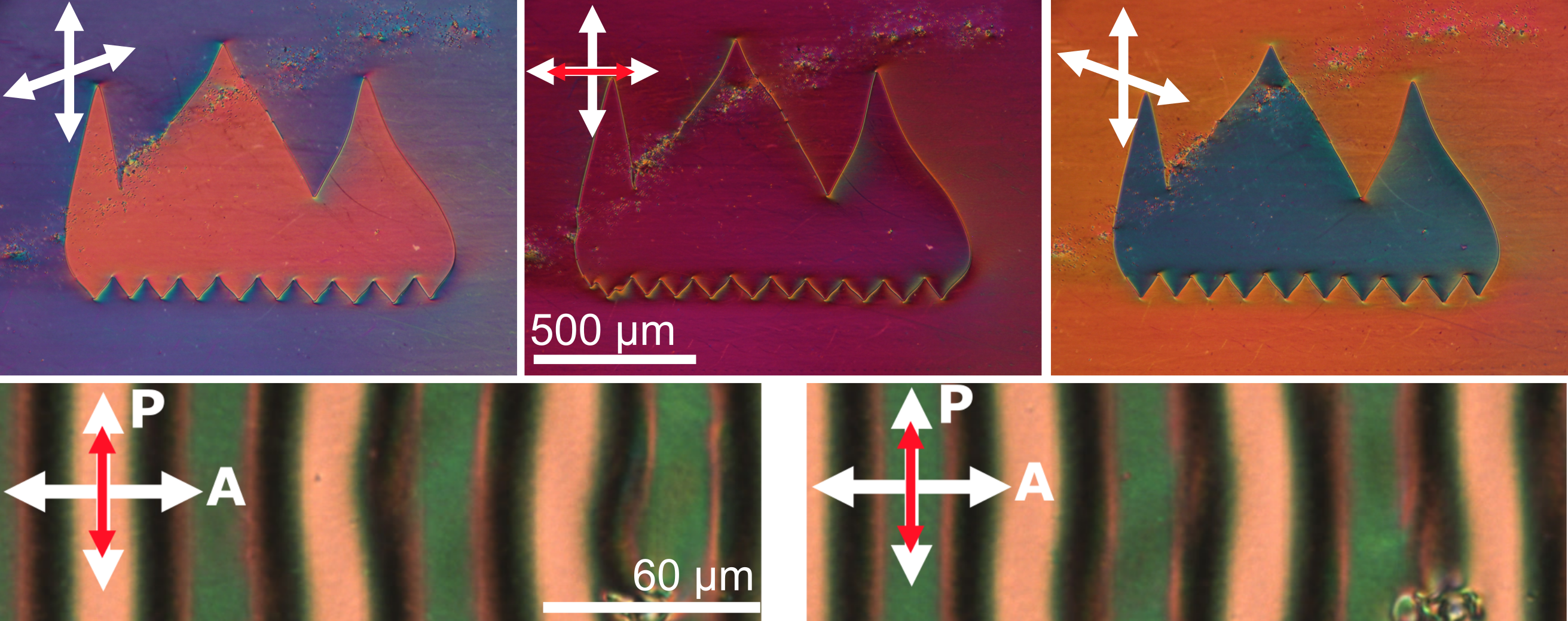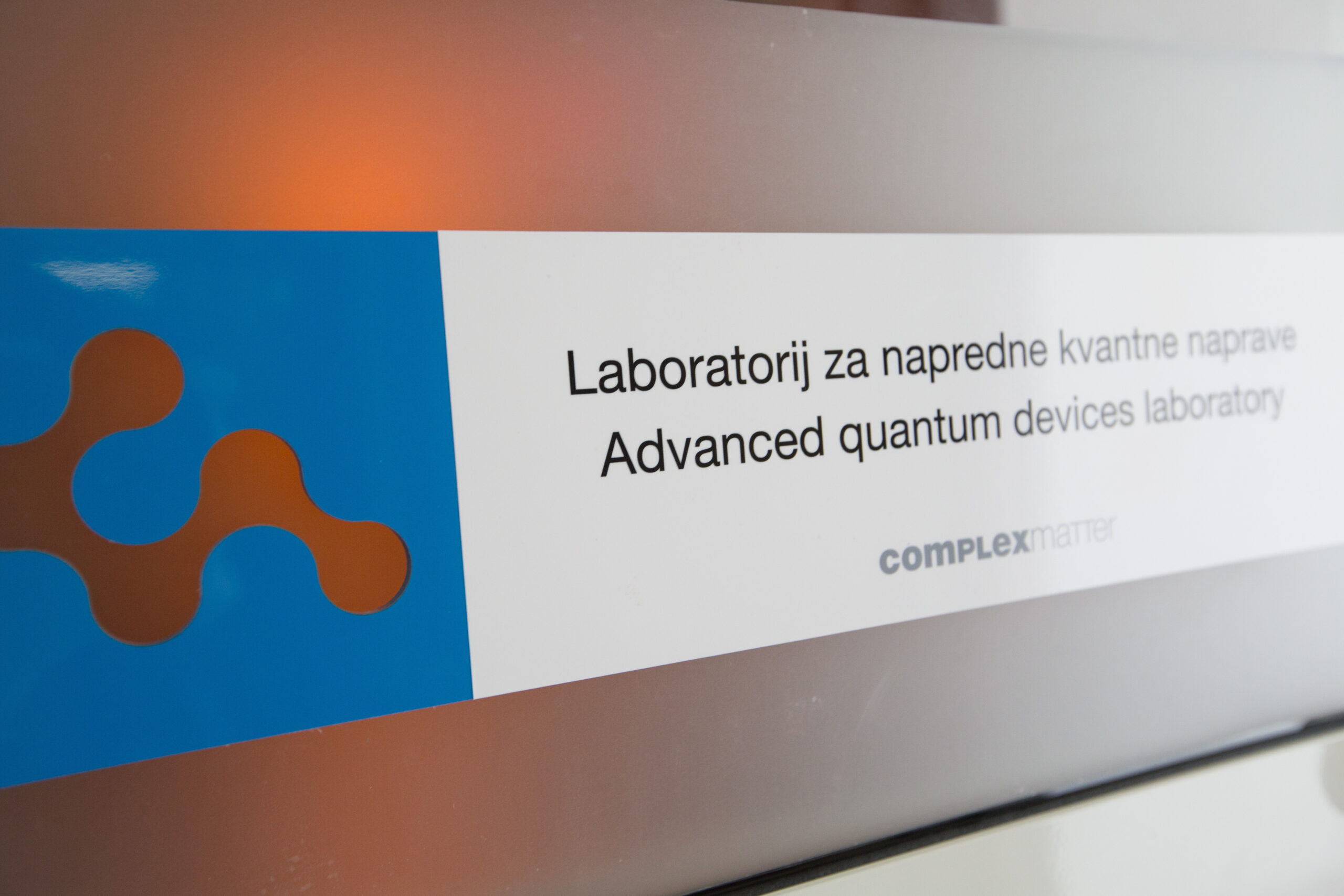The recent experimental realization of ferroelectric nematic liquid crystalline phases has stimulated numerous experimental studies of these phases. We focus on phase and properties characterization, fabrication of custom polarization structures, linear and non-linear electro-optics and mechano-electric effects.
Nematic liquid crystals (NLCs) have been known for years and are broadly exploited in modern display technologies, constituting a multibillion business. The key aspect of their applicability is the unique combination of fluidity, anisotropic physical properties and processability. The “standard” NLC state is uniaxial and non-polar. A polar counterpart was already envisioned more than a hundred years ago by M. Born, but it was not until 2017 that they were experimentally realized.
We participated in the seminal investigations of this new set of materials. The field of ferroelectric nematics has been recognized as an emerging field by the American Physical Society by the invitation to contribute the first Perspectives Phys. Rev. E manuscript. Among various things, our research is focused on:
Effective patterning of electric polarization structures in ferroelectric nematic liquid crystals via exploitation of flexoelectric coupling effects.

We proposed a unique approach how to fabricate electric polarization structures in ferroelectric. We created a series of splayed structures, which exploit and experimentally visualize the flexoelectric coupling between polarization and nematic deformations. One-dimensional splayed photopatterned structures in the confining cells lead to periodic polarization domains, with elongated areas of opposite polarization. This point is proved by second harmonic generation (SHG) microscopy with incorporated interferometry capabilities, to discern the direction and the sign of the polarization. Through this pathway, we also explored the fabrication of 2D periodic SHG arrays, showing that by combining the surface-inscribed alignment with different spontaneous degrees of twist, 2D SHG active arrays can be obtained in the micrometre scale, in which adjacent areas exhibit maximum SHG signals at opposite angles. This work was carried out in collaboration with the group of Prof. Kristiaan Neyts in Ghent University.
N. Sebastian, M. Lovšin, B. Berteloot, N. Osterman, A. Petelin, R.J. Mandle, S. Aya, M. Huang, I. Drevenšek-Olenik, K. Neyts, A. Mertelj, “Polarization patterning in ferroelectric nematic liquids”, Nature Communications, 14, 3029 (2023). doi: 10.1038/s41467-023-38749-2
M. Lovšin, A. Petelin, B. Berteloot, N. Osterman, S. Aya, M. Huang, I. Drevenšek-Olenik, R. J. Mandle, K. Neyts, A. Mertelj and N. Sebastian, “Patterning of 2D second harmonic generation active arrays in ferroelectric nematic fluids”, Giant, 19, 100315 (2024). doi: 10.1016/j.giant.2024.100315
Investigations of the mechanisms leading to the occurrence of nematic polar order in these materials.

In 2018 we started to collaborate with dr. R.J. Mandle from Leeds University in precursor studies of a material (RM734) exhibiting a nematic to nematic phase transition. By a combination of different experimental techniques we have shown that such phase transition is characterized by a significant pretransitional behavior, manifested as strong splay orientational fluctuations. From dielectric spectroscopy and second harmonic generation measurements it was shown that it is indeed a ferroelectric phase transition, in which the growth of polar order is accompanied by the softening of splay fluctuations. We also compared, both experimentally and by means of molecular dynamic simulations, RM734 with a material with a similar chemical structure but not exhibiting ferroelectric nematic phase and demonstrated that a subtle molecular change enables the first to adopt denser packing in the polar order configuration. Such reduction of the excluded volume lies in the origin of the polar nematic phase. This contribution shows how MD simulations can be used for molecular design, by predicting and identifying candidate materials for the polar or its precursor nematic phases.
R.J. Mande, N. Sebastian, J. Martinez-Perdiguero and A. Mertelj, “On the molecular origins of the ferroelectric splay nematic phase”. Nature Communications. 2021, 12, 4962-1-4962-12, doi: 10.1038/s41467-021-25231-0.
N. Sebastian, L. Cmok, R.J. Mandle, M.R. de la Fuente, I. Drevenšek-Olenik, M. Čopič and A. Mertelj, “Ferroelectric-ferroelastic phase transition in a nematic liquid crystal”. Phys. Rev. Lett., 2020, 124, 037801-1-037801-6. doi: 10.1103/PhysRevLett.124.037801, Featured as Editor’s suggestion and Featured in Physics Today: https://doi.org/10.1063/PT.3.4448
A. Mertelj, L. Cmok, N. Sebastián, R. J. Mandle, R. R. Parker, A. C. Whitwood, J. W. Goodby and M. Čopič. Splay nematic phase. Phys. Rev. X, 2018, 8(4), 041025-1-041025-12, doi: 10.1103/PhysRevX.8.041025. Featured in Physics Today: https://doi.org/10.1063/PT.3.4448
Complex electro-optic behavior and modelling.

We also investigated the formation of polar domains up to the millimetre scale when the material is confined in commercial liquid crystal cells, showing the great influence cell surfaces have on the final structure of the polar phase under confinement. We studied the electro-optic in-plane switching behaviour of the prevalent domains showing the polar nature of the coupling with external applied electric fields. We also performed second harmonic generation (SHG) to demonstrate the SHG signal tunability by application of small fields showing the large application potential of this new ferroelectric nematic phase to be employed in photonic applications going beyond the classical LCs ones.
N. Sebastian, R.J. Mande, A. Petelin, A. Eremin and A. Mertelj, “Electrooptics of mm-scale polar domains in the ferroelectric nematic phase”. Liquid Crystals. 2021, 48, 14, 2055-2071. Doi: 10.1080/02678292.2021.1955417. Finalist of the 2021 Luckhurst-Samulski Prize – https://doi.org/10.1080/02678292.2022.2145695
Viscous Mechano- Electric response.
We also explored mechano-electric phenomena in ferroelectric nematic liquid crystals. By placing a room-temperature ferroelectric nematic material into a deformable container with electrodes, we measured the electric current generated by the mechanical actuation of the sample, reporting for the first time viscous mechano-electric response in ferroelectric liquids. Results gave insight into several possible mechanisms of mechano-electric transduction, where ferroelectric ordering within the liquid was changed by material flow induced as a viscous response to external stress. The response to irregular manual actuation and periodic actuation was explored, showing that the observed mechano-electric phenomena are promising for a range of possible applications spanning from simulations of fingertip sensors to energy harvesting from slow ambient mechanical disturbances.
P. Medle Rupnik, L. Cmok, N. Sebastián and A. Mertelj, “Viscous Mechano-Electric Response of Ferroelectric Nematic Liquid”, Advanced Functional Materials, 2024. Doi: 10.1002/adfm.202402554.
